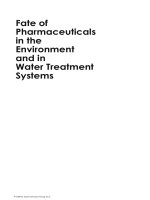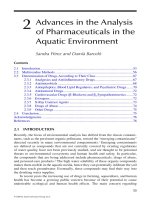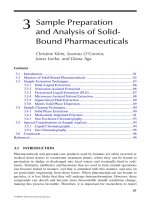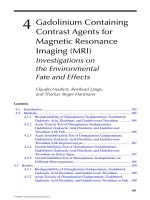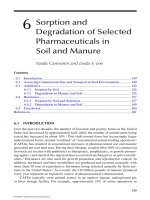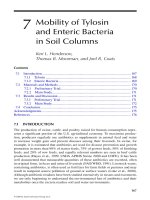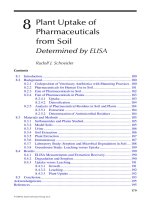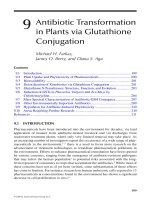Fate of Pharmaceuticals in the Environment and in Water Treatment Systems - Chapter 5 pot
Bạn đang xem bản rút gọn của tài liệu. Xem và tải ngay bản đầy đủ của tài liệu tại đây (196.95 KB, 16 trang )
Part II
Environmental Fate
and Transformations of
Veterinary Pharmaceuticals
© 2008 by Taylor & Francis Group, LLC
123
5
Fate and Transport of
Veterinary Medicines in
theSoilEnvironment
Alistair B.A. Boxall
5.1 INTRODUCTION
Veterinary medicines are widely used to treat disease and protect the health of ani-
mals.Dietaryenhancingfeedadditives(growthpromoters)arealsoincorporated
intothefeedofanimalsrearedforfoodinordertoimprovetheirgrowthrates.Fol-
lowing administration to a treated animal, medicines are absorbed and in some
instancesmaybemetabolized.Releaseofparentveterinarymedicinesandtheir
metabolites to the environment can then occur both directly, for example, the use of
medicinesinshfarms,andindirectly,viatheapplicationofanimalmanure(con-
taining excreted products) to land or via direct excretion of residues onto pasture.
1–4
Over the past 10 years the scientic community has become increasingly interested
in the impacts of veterinary medicines on the environment, and there have been sig-
nicant developments in the regulatory requirements for the environmental assess-
ment of veterinary products. A number of groups of veterinary medicines including
sheep dip chemicals, sh farm medicines, anthelmintics, and antibiotics have been
wellstudiedinrecentyears,andalargebodyofdataisnowavailable.
5
This chapter
Contents
5.1 I
ntroduction 123
5.2 Inputs of Livestock Medicines to the Environment 124
5.3 Fate of Veterinary Medicines in Soils 125
5.3.1 Sorption in Soil 125
5.3.2 Persistence in Soil 127
5.4 Transport of Veterinary Medicines in Soil Systems 128
5.4.1 Leaching to Groundwater 128
5.4.2 Runoff 129
5.4.3 Drain Flow 129
5.4.4 Uptake into Biota 129
5. 5 Modeling Exposur e i n Soils 131
5.6 Occurrence in the Soil Environment 132
5.7 Conclusion 132
References 134
© 2008 by Taylor & Francis Group, LLC
124 Fate of Pharmaceuticals in the Environment and in Water Treatment Systems
reviewsourunderstandingoftheinputsoflivestockmedicinestotheenvironment
andsynthesizestheavailableinformationonthefateandtransportofveterinary
pharmaceuticalsinmanureandsoils.Towardtheendofthischapter,gapsinthecur
-
re
nt knowledge are highlighted and recommendations are made for future research.
5.2 INPUTS OF LIVESTOCK MEDICINES TO THE ENVIRONMENT
Largequantitiesofanimalhealthproductsareusedinagriculturetoimproveani-
mal care and increase production. Some drugs used in livestock production are
poorly absorbed by the gut, and the parent compound or metabolites are known
tobeexcretedinthefecesorurine,irrespectiveofthemethodofapplication.
6–11
Themainroutesofinputtothesoilenvironmentandsubsequenttransportroutes
are illustrated in
Figure 5.1. During l
ivestock production, veterinary drugs enter the
environment through removal and subsequent disposal of waste material (including
manure/slurryand“dirty”waters),viaexcretionoffecesandurinebygrazingani
-
ma
ls, through spillage during external application, via washoff from farmyard hard
surfaces,orbydirectexposure/dischargetotheenvironment.
For hormones, antibiotics, and other pharmaceutical agents administered either
orally or by injection to animals, the major route of entry of the product into the
environment is probably via excretion following use and the subsequent disposal
of contaminated manure onto land.
12
Many intensively reared farm animals are
housed indoors for long periods at a time. Consequently, large quantities of farmyard
manure,slurry,orlitterareproduced,whicharethendisposedofathighapplication
rates onto land.
13
Although each class of livestock production has different housing
andmanureproductioncharacteristics,theemissionanddistributionroutesforvet-
er
inary medicines are essentially similar. Manure or slurry will typically be stored
before it is applied to land. During this storage time it is possible that residues of vet
-
er
inary medicines will be degraded. A number of studies have therefore explored the
Intensively
Reared
Pasture
Manure StorageDirty Water
Soil
Degradates Groundwater BiotaSurface Water
Degradation Leaching
Runoff or
Drainflow
FIGURE 5.1 Input routes and fate and transport pathways for veterinary medicines in the
soil environment.
© 2008 by Taylor & Francis Group, LLC
Fate and Transport of Veterinary Medicines in the Soil Environment 125
persistence of a range of veterinary substances in different manure/slurry types.
14–17
For example, macrolides and C-lactam a
ntibioticshavebeenshowntoberapidly
degraded in a range of manure types, whereas avermectins and tetracyclines are
likely to persist for months. Available data indicate that the dissipation of veterinary
medicinesinmanureorslurrycanbeverydifferentfromthedissipationbehaviorin
soils.
14
Onepossibleexplanationisthatthemechanismofdegradationinmanureand
slurry stores is anaerobic, whereas degradation in soils is most likely due to aerobic
organisms.
Dr
ugsadministere dtog
razinganimalsmaybedepositeddirectlytolandor
surfacewaterthroughdungorurine,exposingsoilorganismstohighlocalcon-
centrations.
6,13,18–20
. Another signicant route for environmental contamination is
the release of substances used in topical applications. Various substances are used
externallyonanimalsandpoultryforthetreatmentofexternalorinternalparasites
andinfection.Sheepinparticularsufferfromanumberofexternalinsectparasites
for which treatment and protection is sometimes obligatory. The main methods of
externaltreatmentincludeplungedipping,pour-onformulations,andtheuseof
showersorjetters.Withallexternallyappliedveterinarymedicines,bothdiffuse
and point source pollution can occur. Sheep dipping activities provide several routes
for environmental contamination. In dipping practice, chemicals may enter water
-
co
urses through inappropriate disposal of used dip, leakage of used dip from dipping
installations, and from excess dip draining from treated animals. Current disposal
practices rely heavily on spreading used dip onto land. Wash-off of chemicals from
the eeces of recently treated animals to soil, water, and hard surfaces may occur on
thefarm,duringtransport,oratstockmarkets.Medicineswashedoff,excreted,or
spilt onto farmyard hardsurfaces (e.g., concrete) may be washed off to surface waters
during periods of rainfall.
5.3 FATE OF VETERINARY MEDICINES IN SOILS
Onceaveterinarymedicineisreleasedtotheenvironment,itsbehaviorwillbedeter-
mined by its underlying physical properties (including water solubility, lipophilicity,
volatility, and sorption potential). In the following sections information on the fate
andtransportofveterinarymedicinesinthesoilenvironmentisreviewed.
5.3.1 SORPTION IN SOIL
Data are available on the sorption behavior of antibiotics, sheep dip chemicals, and
avermectins in soils (Table 5.1). The d
egree to which veterinary medicines may
adsorb to particulates varies widely. Consequently, the mobility of different veteri-
na
rymedicinalproductsalsovarieswidely.Chapter6andChapter7inthisbookdis-
cu
ss sorption and mobility of selected veterinary pharmaceuticals in more detail.
Available data indicate that sulfonamide antibiotics and organophosphate para
-
si
ticideswillbemobileintheenvironment,whereastetracycline,macrolide,and
uoroquinolone antibiotics will exhibit low mobility. The variation in partitioning
for a given compound in different soils can be signicant and cannot be explained
by variations in soil organic carbon. For instance, the maximum reported organic-
© 2008 by Taylor & Francis Group, LLC
126 Fate of Pharmaceuticals in the Environment and in Water Treatment Systems
carbonnormalizedsorptioncoefcientforcarbadoxisapproximatelytwoordersof
magnitude greater than the lowest reported value. These large differences in sorp-
ti
on behavior are explained by the fact that many veterinary medicines are ionizable
withpKavaluesinthepHrangeofnaturalsoils.Medicinescanthereforeoccur
in the environment as negative, neutral, zwitterionic, and positively charged spe
-
cies.
21,22
Depending on the species, interactions with soil can occur through electro-
static attraction, surface bridging, hydrogen bonding, or hydrophobic interactions.
22
Thesorptionbehaviorisalsoinuencedbythepropertiesofthesoil,including
pH, organic carbon content, metal oxide content, ionic strength, and cation-cation
exchange capacity.
22–25
The complexity of the sorbate-sorbent interactions means
that modelling approaches developed for predicting the sorption of other groups of
chemicals (e.g., pesticides and neutral organics) are inappropriate for use on vet
-
erinary medicines (Figure 5.2). Manure a
nd slurry may also alter the behavior and
transport of medicines. Recent studies have demonstrated that the addition of these
matrices can affect the sorption behavior of veterinary medicines and that they may
TABLE 5.1
Measured Sorption Coefficients (Koc) for a Range
of Veterinary Medicines
Mean Minimum Maximum
Avermectin 17650 5300 30000
Chlorfenvinphos 295 — —
Ciprooxacin 61000 — —
Enrooxacin 392623 16506 768740
Cumaphos 13449 5778 21120
Deltamethrin 8380000 460000 16300000
Diazinon 889 229 1549
Fenbendazole 815.5 631 1000
Metronidazole 47 38 56
Ooxacin 44143 — —
Olaquindox 81 46 116
Oxytetracycline 60554 27792 93317
Sulfamethazine 60 — —
Tetracycline 40000 — —
Tylosin 4270.5 553 7988
Carbadox 8508.5 184 16833
Sulfamethoxazole 296.1 62.2 530
Sulfadiazine 125 — —
Sulfapyridine 219 — —
Sulfachloropyridazine 75.5 69 82
Sulfadimethixine 144 — —
(Data taken from review of Boxall et al.
40
With permission.)
© 2008 by Taylor & Francis Group, LLC
Fate and Transport of Veterinary Medicines in the Soil Environment 127
affect persistence.
26,27
TheseeffectshavebeenattributedtochangesinpHorthe
nature of dissolved organic carbon in the soil/manure system.
5.3.2 PERSISTENCE IN SOIL
Themainroutefordegradationofveterinarymedicinesinsoilsisviaaerobicsoil
biodegradation. Degradation rates in soil vary, with half-lives ranging from days
to years. Degradation of veterinary medicines is affected by environmental condi
-
t
i
ons such as temperature and pH and the presence of specic degrading bacteria
thathavedevelopedtodegradegroupsofmedicines.
28,29
As well as varying sig-
nicantly between chemical classes, degradation rates for veterinary medicines also
vary within a chemical class. For instance, of the quinolones, olaquindox can be
consideredtobeonlyslightlypersistent(half-life6to9days),whiledanooxacinis
very persistent (half-life 87 to 143 days). In addition, published data for some indi
-
vidual compounds show persistence varies according to soil type and conditions.
Forexample,diazinonwasshowntoberelativelyimpersistent(half-life1.7days)in
a ooded soil that had been previously treated with the compound, but was reported
to be very persistent in sandy soils (half-life 88 to 112 days).
5
Of the available data,
coumaphos and emamectin benzoate were the most persistent compounds in soil,
with half-lives of 300 and 427 days, respectively, while tylosin and dichlorvos were
theleastpersistentwithhalf-livesof3to8and<1day,respectively.
Forsomeveterinarymedicines,degradationratesinmanurecanbefasterthan
degradation in soil. For example, under methanogenic conditions the degradation
half-lifefortylosinAwaslessthan2daysandwasenhancedbyincreasingconcen
-
tr
ations of manure particles in the incubation medium under aerobic conditions.
15
Moreover,whenmanureiscombinedwithsoil,degradationmaybeenhancedfor
0
1
2
3
4
5
6
7
8
01234567
log Koc (predicted)
log Koc (experimental)
FIGURE 5.2 Relationship between measured and predicted soil sorption coefcients for
a range of veterinary medicine classes. Koc predictions were obtained using the Syracuse
Research Corporation PCKOC program.
© 2008 by Taylor & Francis Group, LLC
128 Fate of Pharmaceuticals in the Environment and in Water Treatment Systems
selected medicines. When manure or slurry is combined with soil, temperature has
beenshowntosignicantlyaffecttherateofdegradationofacompound.Forexam-
ple,ahalf-lifeof91to217dayswasrecordedforivermectininasoil/fecesmixture
during winter weather conditions.
30
In contrast, the compound was shown to degrade
much more rapidly in a soil/feces mixture during the summer period, with a half-
life of 7 to 14 days being measured.
31
Thetimingofapplicationofmanure/slurryto
land may therefore be a signicant factor in determining the subsequent degradation
rate of a compound. Depending on the
nature of the chemical, other degradation and
depletion mechanisms may occur, including soil photolysis and hydrolysis.
32
The
degradation processes may well result in the formation of degradation products.
17
In
some instances, these degradation products may be more ecotoxic than the parent
compound, more persistent, and more mobile.
2
It is therefore important that the fate
ofthedegradationproductsinsoilsisconsideredwhenassessingtheimpactofa
veterinary medicine on the environment.
5.4 TRANSPORT OF VETERINARY MEDICINES IN SOIL SYSTEMS
Contaminantsappliedtosoilcanbetransportedtoaquaticsystemsviasurfacerun-
off, subsurface ow, and drainow. The extent of transport via any of these processes
is determined by a range of factors, including: the solubility, sorption behavior, and
persistenceofthecontaminant;thephysicalstructure,pH,organiccarboncontent,
andcationexchangecapacityofthesoilmatrix;andclimaticconditionssuchastem-
pe
rature and rainfall volume and intensity. Most work to date on contaminant trans-
port from agricultural elds has focused on pesticides, nutrients and bacteria, but
recentlyanumberofstudieshaveexploredthefateandtransportofveterinarymedi-
ci
nes. Lysimeter, eld-plot, and full-scale eld studies have investigated the transport
of veterinary
medicinesfromthesoilsurfacetoelddrains,ditches,streams,rivers,
and groundwater.
33–41
A range of experimental designs and sampling methodologies
has been used. These investigations are described in more detail below.
5.4.1 LEACHING TO GROUNDWATER
Themovementofsulfonamideandtetracyclineantibioticsinsoilproleswasinves-
tigatedattheeldscaleusingsuctionprobes.
33,42
In these studies sulfonamides were
detectedinsoilporewateratdepthsofboth0.8and1.4m,buttetracyclineswerenot
(mostlikelyduetotheirhighpotentialforsorptiontosoil).CarlsonandMabury
43
reported that chlortetracycline applied to agricultural soil in manure was detected at
soildepthsof25and35cm,butmonensinremainedintheuppersoillayers.There
are only a few reports of veterinary medicines in groundwater.
42,44
In an extensive
monitoring study conducted in Germany,
44
noantibioticsweredetectedingroundwa-
terinmostofthemonitoringregionswithintensivelivestockproduction.However,
residues of sulfonamide antibiotics were detected at four sites. While contamination
at two of the sites was attributed to irrigation of agricultural land with domestic
sewage, the authors concluded that contamination of groundwater by the veterinary
antibiotic sulfamethazine at two of the sites was due to applications of manure.
44
© 2008 by Taylor & Francis Group, LLC
Fate and Transport of Veterinary Medicines in the Soil Environment 129
5.4.2 RUNOFF
Transportofveterinarymedicinesviarunoff(i.e.,overlandow)hasbeenobserved
for tetracycline antibiotics (i.e., oxytetracycline) and sulfonamide antibiotics
(sulfadiazine, sulfamethazine, sulfathiazole, and sulfachloropyridazine).
41,45,46
The
transport of these substances is inuenced by the sorption behavior of the com-
pounds, the presence of manure in the soil matrix, and the nature of the land to
which the manure is applied. Runoff of highly sorptive substances, such as tetracy-
cl
ines, was observed to be signicantly lower than the more mobile sulfonamides.
41
However, even for the relatively water soluble sulfonamides, total mass losses to
surfacearesmall(between0.04%and0.6%ofthemassapplied)underactualeld
conditions.
47
Manure and slurry have been shown to increase the transport of sul-
fonamidesviarunoffby10to40timesincomparisontorunofffollowingdirect
application of these medicines to soils.
36
Possible explanations for this observation
include physical “sealing” of the soil surface by the slurry or a change in pH as a
result of manure addition that alters the speciation and fate of the medicines.
36
It has
been shown that overland transport from ploughed soils is signicantly lower than
runoff from grasslands.
45
5.4.3 DRAIN FLOW
The transport of a range of antibacterial substance (i.e., tetracyclines, macrolides,
sulfonamides, and trimethoprim) has been investigated using lysimeter and eld-
based studies in tile-drained clay soils.
38,46,48
Following application of pig slurry
spiked with antibiotics to an untilled eld, test compounds were detected in drain-
owatconcentrationsuptoamaximumof613µgl
–1
for oxytetracyline and 36 µg l
–1
for sulfachloropyridazine.
38
The spiking concentrations for the test compounds were
all similar, so differences in maximum concentrations were likely due to differences
insorptionbehavior.Inasubsequentinvestigationatthesamesite
38
in which the soil
was tilled, much lower concentrations were observed in the drainow (i.e., 6.1 µg l
–1
for sulfachloropyridazine and 0.8 µg l
–1
for oxytetracyline). While the pig slurry used
inthesestudieswasobtainedfromapigfarmwheretylosinwasusedasaprophy-
la
ctic treatment, this substance was not detected in any drainow samples—possibly
becauseitisnotpersistentinslurry.
15
5.4.4 UPTAKE INTO BIOTA
Veterinarymedicinesmayalsobetakenupfromsoilintobiota.
49–51
Studies with a
range of veterinary medicines
51
showed that orfenicol, trimethoprim, levamisole,
diazinon, and enrooxacin are taken up by plants following exposure to soil at envi-
ro
nmentally realistic concentrations of the compounds (Figure 5.3). However, phe
n-
ylbutazone, oxytetracyline, tylosin, sulfadiazine, and amoxicillin were not detected
inplantmaterial.Thelackofuptakeobservedmayhavebeenduetofactorssuch
ashighlimitsofdetectionorsignicantdegradationduringthestudy.Forexample,
resultsforamoxicillin,sulfadiazine,andtylosincouldwellbeexplainedbytheir
dissipation in soils, with greater than 90% dissipation being observed by the time let
-
tu
ces were harvested. The results for sulfadiazine contrasted to previous studies into
© 2008 by Taylor & Francis Group, LLC
130 Fate of Pharmaceuticals in the Environment and in Water Treatment Systems
theuptakeofsulfonamideantibiotics(sulfamethoxine),whereuptakewasobserved
by roots and stems of certain plant species
52,53
followingexposuretohighconcentra-
tionsofthestudycompounds(13to>2000mgkg
–1
). Kumar et al.
50
showed uptake of
chlortetracyclinefrommanureamendedsoilsintocorn(Zea mays L.), green onion
(Allium cepa L.), and cabbage (Brassica oleracea L.).Tylosinwasnottakenupby
the three crops. Chapter 8 of this book presents the results of a study investigating
plant uptake of pharmaceuticals, while Chapter 9 provides evidence of detoxication
of antibiotics by plant-derived enzymes.
It is generally recognized that chemicals are taken up into plants via the soil
pore water. Data for pesticides and neutral organic substances show that root uptake
of organic chemicals from soil water is typically related to the octanol-water parti-
ti
on coefcient of the compound.
54,55
Uptake of chemicals by roots is greatest for
more lipophilic compounds, whereas polar compounds are accumulated to a lesser
extent.
54
Studies of translocation of pesticides into shoots indicate that uptake into
shoots(and,hence,abovegroundplantmaterial)isrelatedtoLogK
ow
by a Gaussian
curve distribution.
54,55
Maximum translocation is observed at a Log K
ow
around 1.8.
More polar compounds are taken up less well by shoots, and uptake of highly lipo-
philic compounds (Log K
ow
>4.5) is low. The available data indicate that these rela-
tionshipsmaynotholdtrueforveterinarymedicines.
51
This is perhaps not surprising
as data for other environmental processes (e.g., sorption to soil) indicate that the
behavior of veterinary medicines in the environment is poorly related to hydropho-
bicity but is determined by a range of factors, including H-bonding potential, cation
0
50
100
150
200
250
Amoxicillin Enrofloxacin Levamisole Phenylbutazone Trimethoprim
Concentration (+g/kg)
Carrots
Lettuce
FIGURE 5.3 Mean (± 1 SE) concentrations of veterinary medicines in plants following 3
monthsexposure(lettuce)and5monthsexposure(carrot)tospikedsoil.(Boxalletal.
51
With
permission.)
© 2008 by Taylor & Francis Group, LLC
Fate and Transport of Veterinary Medicines in the Soil Environment 131
exchange,cationbridgingatclaysurfaces,andcomplexation.Throughcontrolled
experimental studies it may be possible in the future to begin to understand those
factors and processes affecting the uptake of veterinary medicines into plants and to
develop modelling approaches for predicting uptake.
5.5 MODELING EXPOSURE IN SOILS
From the information provided above it is clear that the behavior of veterinary medi-
cinesintheenvironmentiscomplexanddependsonarangeofchemicalproperties
and environmental processes. In order to support the environmental risk assessment
process for veterinary medicines, a number of approaches have therefore been devel-
oped for predicting concentrations of veterinary medicines in soil and the poten-
tial for a medicine to be transported to groundwaters and surface waters.
13,56
These
models incorporate many of the fate processes described above and will typically
requiredataonsorptionandpersistenceasinputvalues.Someoftheapproachesare
described below.
In order to harmonize the environmental assessments of veterinary products, the
EuropeanFederationforAnimalHealth(FEDESAnowIFAHEurope)developeda
uniform scheme for calculating predicted environmental concentrations of veterinary
medicines in soil following spreading of manure from treated animals.
56
The scheme
provides a sequence of standard equations and a database containing information on
three major agricultural species: cattle, pigs, and poultry. The database also contains
information on the agricultural practices and relevant regulations for various regions
within the EU. Inputs to the model are the dose and treatment regime. If informa-
tionisavailableonmetabolismordegradation,thiscanbeincorporatedintothe
calculation. The model calculated the concentration of the veterinary medicine in
animalmanureandthenusesthenitrogencontentofthemanureandthemaximum
spreading rate of manure nitrogen onto land to calculate the maximum quantity of
veterinary medicine applied per hectare. The output from the model is a predicted
soil concentration. Since the introduction of this model there have been a number of
minor modications and amendments introduced, but the basic premise is that the
predicted environmental concentration (PEC) depends on the nitrogen content of the
manureandthemaximumapplicationratetoland.
The ETox models developed by Montforts
13
predicts concentrations of veterinary
medicinesusingscenariosthatarespecictoagriculturalpracticesintheNether-
lands.Themodelismorecomplexthantheuniformapproachandcanbeusedfor
medicinesthataregiveninternally(e.g.,oralandinjectiontreatments)ormedicines
applied externally (e.g., udder disinfection treatments). A range of input pathways are
considered (i.e., direct excretion of dung and urine onto a eld, spreading of manure
andslurry,anddirectspillageontoaeld).Thefollowinggroupsoforganismsare
considered:cows(milkcows,sucklingcows,beefcows),pigs(fatteningpigs,sows),
and poultry (hens, broilers, and turkeys). The outputs from the model include con-
ce
ntrationsoftheveterinarydruginsoil,groundwater,surfacewaters,andbiota.
VetCalcestimatesPECvaluesforsoil,groundwater,andsurfacewaterfor12
predened scenarios that were chosen on the basis of the size and importance of
their livestock production and its diversity, the range of agricultural practice covered
© 2008 by Taylor & Francis Group, LLC
132 Fate of Pharmaceuticals in the Environment and in Water Treatment Systems
by the scenarios, and the desire to cover three different European climate zones
(Mediterranean,Central,andContinentalScandinavian).Eachofthescenarioshas
beenrankedintermsofitsimportanceasascenarioforeachlivestockspecies.
Backgroundinformationonkeydriversforexposuresuchastreatmentregimes(both
body weight and nonbody weight related), animal characteristics and husbandry
practices, manure characteristics and management regimes, environmental charac
-
te
ristics (soil, hydrology, weather), agricultural practices, and chemical parameters
are provided within the model databases.
5.6 OCCURRENCE IN THE SOIL ENVIRONMENT
In recent years a number of studies have begun to explore the occurrence of vet-
erinary medicines in the soil environment resulting from normal agricultural
practices.
57–59
Thesestudieshavefocusedonantibacterialmedicinesandsomepara-
siticides(Table 5. 2). Selected s
tudies have explored the distribution of medicines
inthesoilproleaswellasthepersistenceovertime.Whilesomegroupsofsub-
stances have not been detected in soils (e.g., the macrolides and uoroquinolones),
some classes have been detected at concentrations of tens to hundreds of µg kg
–1
(Table 5.2). In s
ome cases the compounds will persist in the soil for prolonged time
periods. These differences can usually be explained by the laboratory persistence
dataandusageandtreatmentscenariosforthedifferentmedicines.Theavailability
of real-world monitoring data allows us to evaluate the performance of the exposure
models described previously. Generally, these exposure models will overpredict con
-
ce
ntrations of a veterinary medicine in the environment (Figure 5.4) by a
number of
orders of magnitude. The reason for this is that the scenarios used in the models are
highly conservative and that adequate data are not always available to describe the
different dissipation processes that determine how much of a medicine will reach
the soil.
5.7 CONCLUSION
Thispaperhasr eviewed the data available in the public domain on the pathways of
veterinary medicines to the soil environment and their subsequent fate and transport.
Thereisclearlyalargebodyofdataavailableonveterinarymedicinesinthesoil
environment,anditistimelytobegintofurthersynthesizethisinformationinorder
to provide a general understanding of the fate and transport of medicines in the soil
environment and to develop approaches for predicting how a substance will behave
inthesoilenvironment.Thereare,however,stillgapsinthedataandinourunder
-
st
anding.Thosegapsareoutlinedinthefollowingparagraphs.
Researchersarestillfocusingononlyasmallproportionofthemedicinesin
use (including the avermectins, tetracyclines, sulfonamides, macrolides, and uo
-
ro
quinolones).Therearemanymoreclassesofmedicinesinuse,soitwouldbe
worthwhile to prioritize these and begin to develop an understanding of the fate (and
effects) of some of the more important classes in the environment.
A large body of data is now available on the effects of the manure matrix on fate
andtransport,andthereisevidencethatthesematricescanaffecttransportatthe
© 2008 by Taylor & Francis Group, LLC
Fate and Transport of Veterinary Medicines in the Soil Environment 133
eld scale. However, we do not yet fully understand the mechanisms causing these
differencesinbehaviorandtheirimplicationsintermsofenvironmentalrisk.
Informationontheformationandfateofveterinarymedicinemetabolitesis
sparse. It is likely that most metabolites will be less toxic than the parent compounds;
however, they may be more mobile and more persistent than their associate parent.
Furtherworkonmodelcompoundsandtheirmetaboliteswouldhelpidentifythe
circumstances under which metabolites deserve more detailed attention during risk
assessment.
TABLE 5.2
Environmental Monitoring Data for Veterinary Medicines in Agricultural
Soils
Compound
Therapeutic
Use
Concentration
Detected
(µg kg
-1
)
LOD
(µg kg
-1
) Country Reference
Chlortetracycline Antibiotic 9.5 0.7 Germany 42
26.4 1 Germany 42
41.8
39
4
1
2
—
Germany
Germany
US
42
37
58
Ciprooxacin Antibiotic nd 1 UK 48
Enrooxacin Antibiotic nd 1 UK 48
Ivermectin Endectocide 2
46
10.2 US, UK 58
48
Lincomycin Antibiotic 98.5 —
1.26
US
UK
59
48
Monensin Coccidiostat 1.08 — Canada 61
Oxytetracycline Antibiotic 8.6
254
7
305
0.7
—
5
—
Germany
US
Italy
UK
42
59
57
48
Sulfadiazine Antibiotic 0.8 — UK 48
Sulfadimidine Antibiotic 15 — Germany 60
Sulfamethazine Antibiotic 2 0.5 Germany 37
Tetracycline Antibiotic 12.3 0.7 Germany 42
32.2 1 Germany 42
39.6
295
9
11
—
Germany
Germany
US
42
37
59
Tilmicosin Antibiotic <10 — US 59
Trimethoprim Antibiotic 0.5 — UK 48
Tylosin Antibiotic trace
<2
<10
0.2
—
10
Germany
US
Italy
42
59
57
© 2008 by Taylor & Francis Group, LLC
134 Fate of Pharmaceuticals in the Environment and in Water Treatment Systems
The uptake of veterinary medicines into plants is now being considered. It
appearsthatuptakecannotbemodelledusingexistingplantuptakemodelsforpes-
ti
cides and industrial chemicals. Further work to understand the mechanisms of
uptake of veterinary medicine into plants is therefore warranted.
From the information availableit appears that inputs from herd or ocktreatments
areprobablythemostsignicantintermsofenvironmentalexposure.However,the
relativesignicanceofnovelroutesofentry to the environment from livestock treat
-
m
e
nts, such as wash-off following topical treatment and farmyard runoff, and aerial
emissions, have not generally been considered.
Monitoring data are
availableforarangeofveterinarymedicinesinsoils.The
studieshavegenerallyfocusedonparasiticidesandtheantibiotics.Oncefulldata-
se
ts are obtained on the usage, properties, and effects of other chemical groups,
further targeted monitoring should be performed to determine concentrations in the
environment.Thesedatacouldthenbeusedalongwiththeexistingdatatofurther
evaluatecurrentriskassessmentexposuremodels.
REFERENCES
1. Boxall, A.B.A. The environmental side effects of medication. EMBO Reports.5(12),
1110, 2004.
2. Boxall, A.B.A. et al. Are veterinary medicines causing environmental risks?
Environ-
mental Science and Technology
3
7(15), 2003, 286A.
3. Jørgensen, S.E. and Halling-Sørensen, B. Drugs in the environment. Chemosphere,
4
0,
691, 2000.
4. Sarmah,A.K.,Meyer,M.T.,andBoxall,A.B.A.Aglobalperspectiveontheuse,sales,
exposurepathways,fateandeffectsofveterinaryantibiotics(VAs)intheenvironment.
Chemosphere 65(5), 725, 2006.
0.1
1.0
10.0
100.0
1000.0
10000.0
0.1 1.0 10.0 100.0 1000.0
Measured Concentration (+g/kg)
Predicted Concentration (+g/kg)
FIGURE 5.4 Comparison of predicted environmental concentrations obtained using expo-
suremodelslistedintheEUTechnicalGuidanceDocumentwithrangesofmeasuredcon-
centrationsinagriculturalsoils.
© 2008 by Taylor & Francis Group, LLC
Fate and Transport of Veterinary Medicines in the Soil Environment 135
5.Boxall,A.B.A.etal.Veterinarymedicinesintheenvironment.Reviews in Environ-
mental Contamination and Toxicology 1
80,1,2004.
6. Sommer, C. et al. Ivermectin excreted in cattle dung after sub-cutaneous injection or
pour-on treatment: concentrations and impact on dung fauna. Bulletin of Entomologi-
cal Research,
82,257,1992.
7. Magnussen, J.D. et al. Tissue residues and metabolism of avilamycin in swine and rats.
J. Agric. Food Chem.
39,306,1999.
8. Stout, S.J. et al. Maduramycin B:c
haracterisation of 14C-derived residues in turkey
excreta. J. Agric. Food Chem.
39,386,1991.
9. Chiu, S.H.L. et al. Absorption, tissue distribution, and excretion of tritium-labelled
ivermectin in cattle, sheep and rat. J. Agric. Food Chem.,
38, 2072, 1990.
10. Donoho, A.L. Metabolism and residue studies with actaplanin. Drug Metab. Rev. 18
,
163, 1987.
11. Floate, K. et al. Faecal residues of veterinary parasiticides: non-target effects in the
pasture environment.
Annual Reviews in Entomology 5
0, 153, 2005.
12. Halling-Sørenson, B. et al. Worst-case estimations of predicted environmental soil
concentrations (PEC) of selected veterinary antibiotics and residues used in Danish
agriculture. In Kümmerer, K. (Ed.), Pharmaceuticals in the Environment — Sources,
Fate,EffectsandRisks.Springer-Verlag,Germany,2001.
13. Montforts, M.H.M.M. Environmental risk assessment for veterinary medicinal prod
-
uct
s. Part 1: other than GMO-containing and immunological products. RIVM Report
601300001, RIVM, Bilthoven, The Netherlands, 1999.
14. Blackwell,P.A.etal.Anevaluationofalowertierexposureassessmentmodelforvet
-
er
inary medicines. J. Agric. Food Chem. 53
(6), 2192, 2005.
15. Loke,M.L.etal.StabilityoftylosinAinmanurecontainingtestsystemsdetermined
by high performance liquid chromatography. Chemosphere 4
0, 759, 2000.
16. Teeter, J.S. and Meyerhoff, R.D. Aerobic degradation of tylosin in cattle, chicken and
swine excreta. Environmental Research,
93, 45, 2003.
17. Kolz, A.C. et al. Degradation and metabolite production of tylosin in anaerobic and
aerobic swine-manure lagoons. Water Environment Research 7
7(1), 49, 2005.
18. Halling-Sørenson, B. et al. Occurrence, fate and effect of pharmaceutical substances in
the environment—A review. Chemosphere,
36,357,1998.
19. Strong, L. and Wall, R. Effects of ivermectin and moxidectin on the insects of cattle
dung. Bull. Entomol. Res.,
84,403,1994.
20. McCracken, D.I. The potential for avermectins to affect wildlife. Vet. Parasitol.4
8,
273, 1993.
21. Ter Laak, T.L., Gebbink, W.A., and Tolls, J. Estimation of sorption coefcients of vet-
er
inary medicines from soil properties. Environ. Toxicol. Chem.
25(4), 933, 2006.
22. TerLaak,T.L.,Gebbink,W.A.,andTolls,J.TheeffectofpHandionicstrengthonthe
sorption of sulfachloropyridazine, tylosin and oxytetracycline to soil. Environ. Toxicol.
Chem.
25(4), 904, 2006.
23. Strock,T.J.,Sassman,S.A.,andLee,L.S.Sorptionandrelatedpropertiesoftheswine
antibiotic carbadox and associated n-oxide reduced metabolites. Environ. Sci. Technol.
3
9, 3134, 2005.
24. Sassman, S.A. and Lee, L.S. Sorption of three tetracyclines by several soils: assessing
theroleofpHandcationexchange.
Environ. Sci. Technol.
39, 7452, 2005.
25. Jones, A.D., et al. Factors inuencing the sorption of oxytetracycline to soils. Environ.
Toxicol. Chem.
24(4), 761, 2005.
26.Boxall,A.B.A.etal.Thesorptionandtransportofasulphonamideantibioticinsoil
systems. Toxicology Letters 13
1, 19, 2002.
27. Thiele-Bruhn, S. and Aust, M.O. Effects of pig slurry on the sorption of sulfonamide anti-
bi
oticsinsoil.Archives of Environmental Contamination and Toxicology 47
(1), 31, 2004.
© 2008 by Taylor & Francis Group, LLC
136 Fate of Pharmaceuticals in the Environment and in Water Treatment Systems
28.Ingerslev,F.andHallingSorensen,B.Biodegradabilityofmetronidazole,olaquindox
and tylosin and formation of tylosin degradation products in aerobic soil/manure slur-
ries. Chemosphere 48,311,2001.
29. Gilbertson, T.J. et al. Environmental fate of ceftiofur sodium, a cephalosporin antibi-
otic:roleofanimalexcretainitsdecomposition.J. Agric. Food Chem.38,890,1990.
30. Halley, B.A., VandenHeuvel, W.J.A., and Wislocki, P.G. Environmental side effects of
theusageofavermectinsinlivestock.Vet. Parasitol.48,109,1993.
31. Halley, B.A., Jacob, T.A., and Lu, A.Y.H. The environmental impact of the use of iver-
mectin: environmental effects and fate. Chemosphere 1
8, 1543, 1989.
32. Wolters, A.
a
nd Steffens, M. Photodegradation of antibiotics on soil surfaces: labora-
torystudiesonsulfadiazineinanozone-controlledenvironment.Environ. Sci. Tech-
nol. 3
9, 6071, 2005.
33. Blackwell, P.A., Kay, P., and Boxall, A.B.A. The dissipation and transport of veterinary
antibiotics in a sandy loam soil. Chemosphere 67,292,2007.
34. Aga, D.S., Goldsh, R., and Kulshrestha, P. Application of ELISA in determining the
fateoftetracyclinesinland-appliedlivestockwastes.Analyst 128, 658, 2003.
35. Kreuzig,R.andHoltge,S.Investigationsonthefateofsulfadiazineinmanuredsoil:
laboratory experiments and test plot studies. Environmental Toxicology and Chemis-
try,24,771,2005.
36. Burkhard, M. et al. Surface runoff and transport of sulfonamide antibiotics on manured
grassland. Journal of Environmental Quality 34, 1363, 2005.
37. Hamscher, G. et al. Different behaviour of tetracyclines and sulfonamides in sandy
soils after repeated fertilization with liquid manure. Environ. Toxicol. Chem.24(4),
861, 2005.
38.Kay,P.,Blackwell,P.,andBoxall,A.Fateandtransportofveterinaryantibioticsin
drained clay soils. Environ. Toxicol. Chem. 23, 1136, 2004.
39. Kay,P.,Blackwell,P.A.,andBoxall,A.B.A.Alysimeterexperimenttoinvestigatethe
leaching of veterinary antibiotics through a clay soil and comparison with eld data.
Environmental Pollution 1
34, 333, 2005.
40.Kay,P.,Blackwell,P.A.,andBoxall,A.B.A.Columnstudiestoinvestigatethefateof
veterinaryantibioticsinclaysoilsfollowingslurryapplicationtoagriculturalland.
Chemosphere 60(4),497,2005.
41. Kay,P.,Blackwell,P.A.,andBoxall,A.B.A.Transportofveterinaryantibioticsinover-
landowfollowingtheapplicationofslurrytoland.Chemosphere 59(7), 951, 2005.
42. Hamscher, G. et al. Substances with pharmacological effects including hormonally
active substances in the environment: identication of tetracyclines in soil fertilised
with animal slurry. Dtsch. tierärztl. Wschr.107,293,2000.
43. Carlson, J.C. and Mabury, S.A. Dissipation kinetics and mobility of chlortetracycline,
tylosin, and monensin in an agricultural soil in Northumberland County, Ontario, Can-
ada. Environ. Toxicol. Chem.25,1,2006.
44. Hirsch, R. et al. Occurrence of antibiotics in the aquatic environment. Sci. Tot. Envi-
ron. 2
25,109,1999.
45. Kreuzig, R. et al. Test plot studies on runoff of sulfonamides from manured soils after
sprinkler irrigation. Environ. Toxicol. Chem.
24, 777, 2005.
46. Gupta, S. et al. Antibiotic losses in runoff and drainage from manure applied elds.
USGS-WRRI 104G National Grant, 2003.
47. Stoob,K.,Singer,H.P.,MuellerS.R.,Schwarzenbach,R.P.,andStamm,C.H.Dissipa-
tion and transport of veterinary sulphonamide antibiotics after manure application to
grasslandinasmallcatchment.Environ. Sci. Technol., in press.
48. Boxall, A. et al. Targeted Monitoring Study for Veterinary Medicines. Environment
Agency R&D Technical Report, Bristol, UK, Environment Agency, 2006.
© 2008 by Taylor & Francis Group, LLC
Fate and Transport of Veterinary Medicines in the Soil Environment 137
49. Migliore,L.,Cozzolino,S.,andFiori,M.Phytotoxicityanduptakeofenrooxacinin
crop plants.
Chemosphere
5
2, 1233, 2003.
50. Kumar, K. et al. Antibiotic uptake by plants from soil fertilized with animal manure.
Journal of Environmental Quality 34(6), 2082, 2005.
51. Boxall,A.B.A.etal.Uptakeofveterinarymedicinesfromsoilsintoplants.
J. Agric.
Food Chem. 54(6), 2288, 2006.
52. Migliore,L.etal.Effectonplantsofsulfadimethoxineusedinintensivefarming(Pani
-
c
u
mmiliacaum,PisumsativumandZeaMays).
Agriculture Ecosystems and Environ-
ment 52,103,1995.
53. Migliore,L.etal.Effectofsulphadimethoxinecontaminationonbarley(Hordeumdisti
-
c
h
um L, Poaceae, Lilipidosa).
Agricultural Ecosystems and Environment 6
0,1
21,1996.
54. Briggs, G., Bromilow, R., and Evans, A. Relationships between lipophilicity and root
uptake and translocation of non-ionised chemicals by barley.
Pesticide Science 13, 495,
1982.
55
. Burken, J. and Schnoor, J. Predictive relationships for uptake of organic contaminants
by hybrid polar tress.
Environ. Sci. Technol. 32, 3379, 1998.
56. Spaepen, K.R.I. et al. A uniform procedure to estimate the predicted environmental
concentration of the residues of veterinary medicines in soil.
Environ. Toxicol. Chem.
1
6, 1977, 1997.
57.DeLiguoro,M.etal.Useofoxytetracyclineandtylosininintensivecalffarming:
evaluationoftransfertomanureandsoil.
Chemosphere
5
2, 203, 2003.
58. Nessel, R.J. et al. Environmental fate of ivermectin in a cattle feedlot.
Chemosphere,
1
8, 1531, 1989.
59. Zilles, J. et al. Presence of macrolide-lincosamide-streptogramin B and tetracycline
antimicrobials in swine waste treatment processes and amended soil.
Water Environ.
Res., 7
7, 57, 2005.
60. Christian, T. et al. Determination of antibiotic residues in manure, soil and surface
waters.
Acta Hydrochim. Hydrobiol. 31(1), 36, 2003.
61. Donoho, A.L. Biochemical studies on monensin.
J. Anim. Sci.
5
8, 1528, 1984.
© 2008 by Taylor & Francis Group, LLC
